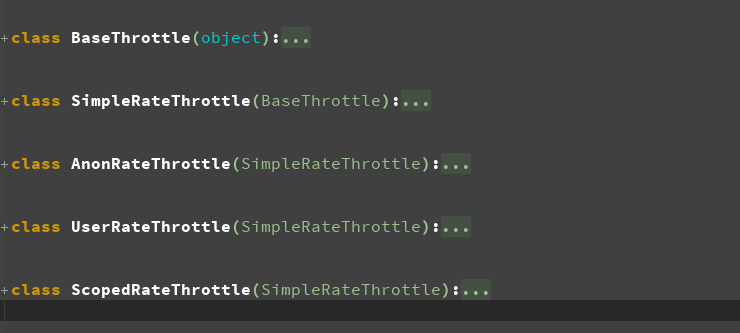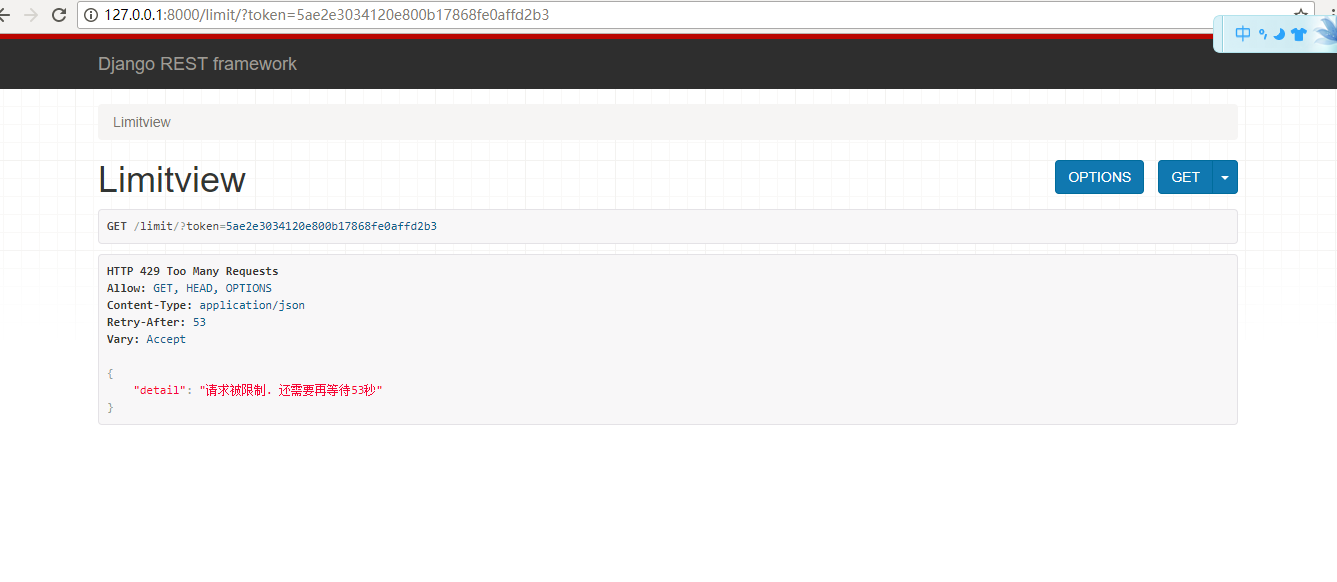基于 http://www.cnblogs.com/ctztake/p/8419059.html
当用发出请求时 首先执行dispatch函数,当执行当第二部时:
#2.处理版本信息 处理认证信息 处理权限信息 对用户的访问频率进行限制
self.initial(request, *args, **kwargs)
进入到initial方法:
def initial(self, request, *args, **kwargs): """ Runs anything that needs to occur prior to calling the method handler. """ self.format_kwarg = self.get_format_suffix(**kwargs) # Perform content negotiation and store the accepted info on the request neg = self.perform_content_negotiation(request) request.accepted_renderer, request.accepted_media_type = neg # Determine the API version, if versioning is in use. #2.1处理版本信息 version, scheme = self.determine_version(request, *args, **kwargs) request.version, request.versioning_scheme = version, scheme # Ensure that the incoming request is permitted #2.2处理认证信息 self.perform_authentication(request) #2.3处理权限信息 self.check_permissions(request) #2.4对用户的访问频率进行限制 self.check_throttles(request)
#2.4对用户的访问频率进行限制 self.check_throttles(request)
下面 开始 限流的具体分析:
一、执行check_throttles方法
def check_throttles(self, request): """ Check if request should be throttled. Raises an appropriate exception if the request is throttled. """ #遍历throttle对象列表 for throttle in self.get_throttles(): #根据allow_request()的返回值进行下一步操作,返回True的话不执行下面代码,标识不限流,返回False的话执行下面代码,还可以抛出异常 if not throttle.allow_request(request, self): #返回False的话执行 self.throttled(request, throttle.wait())
二、执行allow_request方法
首先找到BaseThrottle类,有好多类继承了该类,并且都有allow_request方法,至于执行那个类中的allow_request方法,取决于我们自定义的Throttle这个类继承谁

class BaseThrottle(object): """ Rate throttling of requests. """ def allow_request(self, request, view): """ Return `True` if the request should be allowed, `False` otherwise. """ raise NotImplementedError('.allow_request() must be overridden') #获取唯一标识,匿名用户用ip地址,认证用户用自己的user信息 def get_ident(self, request): """ Identify the machine making the request by parsing HTTP_X_FORWARDED_FOR if present and number of proxies is > 0. If not use all of HTTP_X_FORWARDED_FOR if it is available, if not use REMOTE_ADDR. """ xff = request.META.get('HTTP_X_FORWARDED_FOR') remote_addr = request.META.get('REMOTE_ADDR') num_proxies = api_settings.NUM_PROXIES if num_proxies is not None: if num_proxies == 0 or xff is None: return remote_addr addrs = xff.split(',') client_addr = addrs[-min(num_proxies, len(addrs))] return client_addr.strip() return ''.join(xff.split()) if xff else remote_addr def wait(self): """ Optionally, return a recommended number of seconds to wait before the next request. """ return None
三、具体分析以具有代表性的SimpleRateThrottle类分析
class SimpleRateThrottle(BaseThrottle): """ A simple cache implementation, that only requires `.get_cache_key()` to be overridden. The rate (requests / seconds) is set by a `throttle` attribute on the View class. The attribute is a string of the form 'number_of_requests/period'. Period should be one of: ('s', 'sec', 'm', 'min', 'h', 'hour', 'd', 'day') Previous request information used for throttling is stored in the cache. """ cache = default_cache timer = time.time cache_format = 'throttle_%(scope)s_%(ident)s' scope = None THROTTLE_RATES = api_settings.DEFAULT_THROTTLE_RATES def __init__(self): #判断是否有rate,实际上rate就是我们定义的scope的值 if not getattr(self, 'rate', None): #没有调用get_rate()获取 self.rate = self.get_rate() #num_requests代表具体的次数 duration代表具体的时间单位 self.num_requests, self.duration = self.parse_rate(self.rate) def get_cache_key(self, request, view): """ Should return a unique cache-key which can be used for throttling. Must be overridden. May return `None` if the request should not be throttled. """ raise NotImplementedError('.get_cache_key() must be overridden') def get_rate(self): """ Determine the string representation of the allowed request rate. """ #判断当前类中我们定义的scope是否有值,没有则抛出异常,告诉我们必须设置scope if not getattr(self, 'scope', None): msg = ("You must set either `.scope` or `.rate` for '%s' throttle" % self.__class__.__name__) raise ImproperlyConfigured(msg) try: #有的话直接返回scope对应的值 return self.THROTTLE_RATES[self.scope] except KeyError: msg = "No default throttle rate set for '%s' scope" % self.scope raise ImproperlyConfigured(msg) def parse_rate(self, rate): """ Given the request rate string, return a two tuple of: <allowed number of requests>, <period of time in seconds> """ if rate is None: return (None, None) #rate实际就是我们自定义的scope的值 如10/m(代表10次每分钟) #按'/'切分num代表次数,period代表时间 num, period = rate.split('/') #多少次 num_requests = int(num) #获取具体的时间单位 duration = {'s': 1, 'm': 60, 'h': 3600, 'd': 86400}[period[0]] return (num_requests, duration) def allow_request(self, request, view): """ Implement the check to see if the request should be throttled. On success calls `throttle_success`. On failure calls `throttle_failure`. """ #如果没有rate也就是scope没有值 #如果没有则表示不限流, if self.rate is None: return True #get_cache_key必须自己重写,如果没有则表示不限流 #key一般是唯一标示如用户名密码 或者登陆者的ip地址 self.key = self.get_cache_key(request, view) if self.key is None: return True #获取当前key所对应的时间列表,也就是用户每一次访问的时间都放到该列表中 self.history = self.cache.get(self.key, []) #当前时间 self.now = self.timer() # Drop any requests from the history which have now passed the # throttle duration #当时间列表存在,并且当前时间已经超出了规定的时间 while self.history and self.history[-1] <= self.now - self.duration: #把最开始加进去的时间删除 self.history.pop() #如果列表中的时间数大于规定执行的次数 if len(self.history) >= self.num_requests: #则return False return self.throttle_failure() #return True return self.throttle_success() def throttle_success(self): """ Inserts the current request's timestamp along with the key into the cache. """ self.history.insert(0, self.now) self.cache.set(self.key, self.history, self.duration) return True def throttle_failure(self): """ Called when a request to the API has failed due to throttling. """ return False def wait(self): """ Returns the recommended next request time in seconds. """ if self.history: #计算等待时间(也就是等待多久可以才可以访问下一次) remaining_duration = self.duration - (self.now - self.history[-1]) else: remaining_duration = self.duration #在规定的时间内还可以访问多少次 available_requests = self.num_requests - len(self.history) + 1 if available_requests <= 0: return None return remaining_duration / float(available_requests)
四、回到第一步,执行allow_request方法
def allow_request(self, request, view): """ Implement the check to see if the request should be throttled. On success calls `throttle_success`. On failure calls `throttle_failure`. """ #如果没有rate也就是scope没有值 #如果没有则表示不限流, if self.rate is None: return True #get_cache_key必须自己重写,如果没有则表示不限流 #key一般是唯一标示如用户名密码 或者登陆者的ip地址 self.key = self.get_cache_key(request, view) if self.key is None: return True #获取当前key所对应的时间列表,也就是用户每一次访问的时间都放到该列表中 self.history = self.cache.get(self.key, []) #当前时间 self.now = self.timer() # Drop any requests from the history which have now passed the # throttle duration #当时间列表存在,并且当前时间已经超出了规定的时间 while self.history and self.history[-1] <= self.now - self.duration: #把最开始加进去的时间删除 self.history.pop() #如果列表中的时间数大于规定执行的次数 if len(self.history) >= self.num_requests: #则return False return self.throttle_failure() #return True return self.throttle_success()
根据allow_request方法的返回值确定具体执行,返回False的话执行
#根据allow_request()的返回值进行下一步操作,返回True的话不执行下面代码,标识不限流,返回False的话执行下面代码,还可以抛出异常 if not throttle.allow_request(request, self): #返回False的话执行 self.throttled(request, throttle.wait())
def throttled(self, request, wait): """ If request is throttled, determine what kind of exception to raise. """ raise exceptions.Throttled(wait)
class Throttled(APIException): status_code = status.HTTP_429_TOO_MANY_REQUESTS default_detail = _('Request was throttled.') extra_detail_singular = 'Expected available in {wait} second.' extra_detail_plural = 'Expected available in {wait} seconds.' default_code = 'throttled' def __init__(self, wait=None, detail=None, code=None): if detail is None: detail = force_text(self.default_detail) if wait is not None: wait = math.ceil(wait) detail = ' '.join(( detail, force_text(ungettext(self.extra_detail_singular.format(wait=wait), self.extra_detail_plural.format(wait=wait), wait)))) self.wait = wait super(Throttled, self).__init__(detail, code)
例子:继承BaseThrottle
url(r'^limit/', app03_views.Limitview.as_view()),

import time from django.shortcuts import render from rest_framework.views import APIView from rest_framework.response import Response from rest_framework.throttling import BaseThrottle from rest_framework import exceptions # Create your views here. AllOW={} class MyThrottle(BaseThrottle): ''' 要求每分钟只能访问十次 ''' ip = '1.1.1.1' def allow_request(self, request, view): ctime=time.time() ip=self.ip if ip not in AllOW: AllOW[ip]=[ctime,] else: time_list=AllOW[ip] while True: if ctime-60>time_list[-1]: time_list.pop() else : break if len(AllOW[ip])>10: return False AllOW[ip].insert(0,ctime) return True def wait(self): ip=self.ip ctime=time.time() first_in_time=AllOW[ip][-1] wt=60-(ctime-first_in_time) return wt class Limitview(APIView): throttle_classes=[MyThrottle,] def get(self,reques): self.dispatch() return Response('欢迎访问') def throttled(self,request,wait): class InnerThrottled(exceptions.Throttled): default_detail = '请求被限制.' extra_detail_singular = 'Expected available in {wait} second.' extra_detail_plural = '还需要再等待{wait}秒' raise InnerThrottled(wait)

REST_FRAMEWORK = { 'UNAUTHENTICATED_USER': None, 'UNAUTHENTICATED_TOKEN': None, "DEFAULT_AUTHENTICATION_CLASSES": [ # "app01.utils.MyAuthentication", "app02.utils.MyAuthentication", ], "DEFAULT_PERMISSION_CLASSES":[ "app02.utils.MyPermission", "app02.utils.AdminPermission", ], }
seetings中没有配置跟Throttle有的的信息

继承SimpleRateThrottle

url(r'^limit/', app03_views.Limitview.as_view()),

import time from django.shortcuts import render from rest_framework.views import APIView from rest_framework.response import Response from rest_framework.throttling import BaseThrottle from rest_framework.throttling import SimpleRateThrottle from rest_framework import exceptions # Create your views here. AllOW={} class MyThrottle(BaseThrottle): ''' 要求每分钟只能访问十次 ''' ip = '1.1.1.1' def allow_request(self, request, view): ctime=time.time() ip=self.ip if ip not in AllOW: AllOW[ip]=[ctime,] else: time_list=AllOW[ip] while True: if ctime-60>time_list[-1]: time_list.pop() else : break if len(AllOW[ip])>10: return False AllOW[ip].insert(0,ctime) return True def wait(self): ip=self.ip ctime=time.time() first_in_time=AllOW[ip][-1] wt=60-(ctime-first_in_time) return wt class MySimpleRateThrottle(SimpleRateThrottle): #必须要写因为SimpleRateThrottle中要求了必须写 ''' def get_rate(self): """ Determine the string representation of the allowed request rate. """ #判断当前类中我们定义的scope是否有值,没有则抛出异常,告诉我们必须设置scope if not getattr(self, 'scope', None): msg = ("You must set either `.scope` or `.rate` for '%s' throttle" % self.__class__.__name__) raise ImproperlyConfigured(msg) ''' scope = 'tiga' #也必须必须要写 ''' def get_cache_key(self, request, view): """ Should return a unique cache-key which can be used for throttling. Must be overridden. May return `None` if the request should not be throttled. """ raise NotImplementedError('.get_cache_key() must be overridden') ''' def get_cache_key(self, request, view): return self.get_ident(request) class Limitview(APIView): throttle_classes=[MySimpleRateThrottle,] def get(self,reques): return Response('欢迎访问') def throttled(self,request,wait): class InnerThrottled(exceptions.Throttled): default_detail = '请求被限制.' extra_detail_singular = 'Expected available in {wait} second.' extra_detail_plural = '还需要再等待{wait}秒' raise InnerThrottled(wait)

from django.db import models # Create your models here. class Userinfo(models.Model): name=models.CharField(max_length=32,verbose_name='用户名') pwd=models.CharField(max_length=32,verbose_name='密码') token=models.CharField(max_length=64,null=True) def __str__(self): return self.name

REST_FRAMEWORK = { 'UNAUTHENTICATED_USER': None, 'UNAUTHENTICATED_TOKEN': None, "DEFAULT_AUTHENTICATION_CLASSES": [ # "app01.utils.MyAuthentication", "app02.utils.MyAuthentication", ], "DEFAULT_PERMISSION_CLASSES":[ "app02.utils.MyPermission", "app02.utils.AdminPermission", ], "DEFAULT_THROTTLE_RATES":{ 'tiga':'10/m', } }
认证,权限,限流综合联系

url(r'^index/', app04_views.IndexView.as_view()), url(r'^user/', app04_views.UserView.as_view()), url(r'^manage/', app04_views.ManageView.as_view()),

from django.shortcuts import render from rest_framework.views import APIView from rest_framework.response import Response from rest_framework.authentication import BaseAuthentication from rest_framework.permissions import BasePermission from rest_framework.throttling import SimpleRateThrottle from rest_framework import exceptions from app01 import models # Create your views here. class MyAuthentication(BaseAuthentication): def authenticate(self, request): token=request.query_params.get('token') user=models.Userinfo.objects.filter(token=token).first() if user: return (user.name,user) return None class UserPermission(BasePermission): message='登录用户才可以访问' def has_permission(self, request, view): if request.user: return True return False class AdminPermission(BasePermission): message='管理员才能访问' def has_permission(self, request, view): if request.user =='ctz': return True return False class AnnoThrottle(SimpleRateThrottle): scope = 'anno' def get_cache_key(self, request, view): #如果是匿名用户则执行 if not request.user: return self.get_ident(request) #如果不是匿名用户则让他执行 return None class UserThrottle(SimpleRateThrottle): scope = 'user' def get_cache_key(self, request, view): #当前用户登陆了,并且当前用户不是管理员 if request.user and request.user!='ctz': return self.get_ident(request) #如果是匿名用户和管理员 则让他继续执行 return None class AdminThrottle(SimpleRateThrottle): scope = 'admin' def get_cache_key(self, request, view): #如果是管理员 if request.user=='ctz': return self.get_ident(request) #不是管理员 return None class IndexView(APIView): ''' 要求,所有用户都能访问,匿名用户5/m,普通用户10/m,管理员不限 ''' authentication_classes = [MyAuthentication,] permission_classes = [] throttle_classes = [AnnoThrottle,UserThrottle,AdminThrottle] def get(self,request): return Response('首页') def throttled(self, request, wait): class UserInnerThrottled(exceptions.Throttled): default_detail = '请求被限制.' extra_detail_singular = 'Expected available in {wait} second.' extra_detail_plural = '还需要再等待{wait}秒' raise UserInnerThrottled(wait) class UserView(APIView): ''' 要求:登录用户能访问,普通用户10/m,管理员20/m ''' authentication_classes = [MyAuthentication,] permission_classes = [UserPermission,] throttle_classes = [UserThrottle,AdminThrottle] def get(self,request): return Response('用户界面') def permission_denied(self, request, message=None): """ If request is not permitted, determine what kind of exception to raise. """ if request.authenticators and not request.successful_authenticator: raise exceptions.NotAuthenticated('无权访问') raise exceptions.PermissionDenied(detail=message) def throttled(self, request, wait): class UserInnerThrottled(exceptions.Throttled): default_detail = '请求被限制.' extra_detail_singular = 'Expected available in {wait} second.' extra_detail_plural = '还需要再等待{wait}秒' raise UserInnerThrottled(wait) class ManageView(APIView): ''' 要求:只有管理园能访问,5/m ''' authentication_classes = [MyAuthentication,] permission_classes = [AdminPermission,] throttle_classes = [AdminThrottle] def get(self,request): return Response('管理员界面') def permission_denied(self, request, message=None): """ If request is not permitted, determine what kind of exception to raise. """ if request.authenticators and not request.successful_authenticator: raise exceptions.NotAuthenticated('无权访问') raise exceptions.PermissionDenied(detail=message) def throttled(self, request, wait): class UserInnerThrottled(exceptions.Throttled): default_detail = '请求被限制.' extra_detail_singular = 'Expected available in {wait} second.' extra_detail_plural = '还需要再等待{wait}秒' raise UserInnerThrottled(wait)

from django.db import models # Create your models here. class Userinfo(models.Model): name=models.CharField(max_length=32,verbose_name='用户名') pwd=models.CharField(max_length=32,verbose_name='密码') token=models.CharField(max_length=64,null=True) def __str__(self): return self.name

REST_FRAMEWORK = { 'UNAUTHENTICATED_USER': None, 'UNAUTHENTICATED_TOKEN': None, "DEFAULT_AUTHENTICATION_CLASSES": [ # "app01.utils.MyAuthentication", "app02.utils.MyAuthentication", ], "DEFAULT_PERMISSION_CLASSES":[ "app02.utils.MyPermission", "app02.utils.AdminPermission", ], "DEFAULT_THROTTLE_RATES":{ 'tiga':'10/m', 'anno':'5/m', 'user':'10/m', 'admin':'20/m', } }
